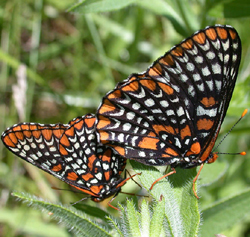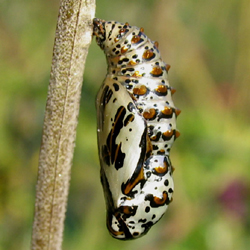Find a Butterfly
Baltimore Checkerspot
Euphydryas phaeton
Named
Drury, 1773

Identification
Wingspan: 1 5/8-2 1/2". The Baltimore Checkerspot is distinct among eastern butterflies: Wings largely black with 2-3 submarginal rows of white spots and a wide border of orange. The Harris‘ Checkerspot, a much less common species in Massachusetts, has a similar underwing pattern.
Distribution
Southern Manitoba east to Nova Scotia and south to Nebraska, Arkansas, and Georgia. Ranges throughout New England, excepting northern Maine.
Status in Massachusetts
The status of the Baltimore Checkerspot in Massachusetts has changed markedly in recent years. Earlier accounts of the species, including Scudder‘s writings on Massachusetts butterflies, spoke of the remarkably local nature of the Baltimore Checkerspot. Farquhar (1934) called it locally common. Today, in most of the state, the Baltimore Checkerspot is still quite local, occurring in small numbers. In southeastern Massachusetts, however, this species is becoming a common meadow species, occasionally to be found in colonies of 1000 or more, rarely 5000 or more. Expansion of larval food preferences (see below) is the likely cause of the Baltimore Checkerspot‘s population explosion in southeastern Massachusetts. Maxima: 10,000 - 20,000 on 16 July 1989, South Dartmouth (Bristol Co.) and 7000 on 27 June 1989, West Bridgewater (Plymouth Co.).

Flight Period in Massachusetts
Typically mid June to mid July. Extreme dates: 28 May 1987, Wrentham (Norfolk Co.), B. Cassie and 8 August 1992, Stoughton (Norfolk Co.), B. Cassie et al.
Larval Food Plants
Known to feed on Turtlehead (Chelone glabra), White Ash (Fraxinus americana), Arrowwood (Viburnum recognitum), English Plantain (Plantago lanceolata), Common Plantain (P. major), Honeysuckle (Lonicera ciliata) and False Foxglove (Gerardia, sp.) in Massachusetts, and has been recorded elsewhere on Hairy Beardtongue (Penstemon hirsutus). Turtlehead is most often cited as the preferred larval food source, but in southeastern Massachusetts, English Plantain probably supports most of the populations throughout their larval development.
Adult Food sources
Said by Opler and Krizek (1984) to visit flowers infrequently, but in our region frequents a variety of midsummer flowering species, including Glossy Buckthorn, Silky Dogwood, numerous milkweeds, Black eyed Susan, and Queen Anne‘s Lace. Found visiting 22 species of flowers during the Atlas period.

Habitat
The Baltimore Checkerspot in Massachusetts is essentially a meadow species, and may be found in both wet and dry meadow communities. It also occurs in bogs and surrounding vegetation, and rarely in upland wooded habitats (Middlesex Fells).
Life Cycle
EGG: Yellow when first laid, becoming purplish; dome shaped, but with depressed summit. OVIPOSITION: Eggs laid in clusters of 100 700, on the underside of hostplant leaves; they hatch in about twenty days. LARVA: Banded orange and black, with conspicuous black spines; larvae live in a communal nest, constructed with silk on the food plant. The young caterpillars climb to the top of the plant and construct a web, in which they live and feed communally throughout their early development. They suspend feeding in early autumn, and descend to the base of the food plant, where they spend the winter in diapause in compact groups in the leaf litter. Upon emerging from the ground in late April or early May, the larvae continue feeding, at this season being less particular about their food items; e.g. they may be found on White Ash (particularly tiny saplings) Arrowwood, and other food plants. CHRYSALIS: Whitish, with orange tubercles and black splotches. Adults fly close to the ground in suitable habitat and have been observed mating during afternoon hours.
Notes
English Plantain was first recorded as an oviposition plant for Baltimore Checkerspots in 1979 (Stamp, 1979). Since then, in parts of its range, the Baltimore Checkerspot has colonized fields of English Plantain to an astonishing degree. In Massachusetts, colonies of 1000+ individuals were found (1989 1990) at Dartmouth, South Dartmouth, and Swansea (Bristol Co.), Dennis (Barnstable Co.), and West Bridgewater (Plymouth Co.), all in direct association with English Plantain.
Baltimore Checkerspot larvae feeding on Turtlehead are unpalatable and those using plantain throughout the larval life cycle may be similarly toxic. Harris‘ Checkerspot, a slightly smaller relative of the Baltimore Checkerspot, mimics the Baltimore Checkerspot‘s underwing pattern and, sharing the same habitat and flight period, gains protection from predators, which avoid the vivid coloration of both the model and the mimic. (Bowers, 1983)
A striking color variant, in which the white markings in the wings of the Baltimore Checkerspot are replaced by black was noted in Massachusetts during the Atlas period, with as many as four individuals in the same field in West Bridgewater.
Account Author
Brian Cassie
Additional Information
Read more on this species at the North American Butterfly Association.



